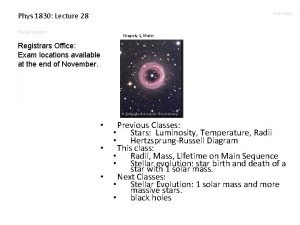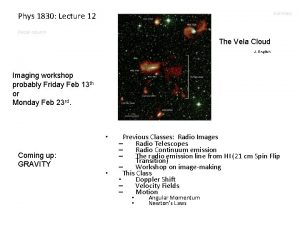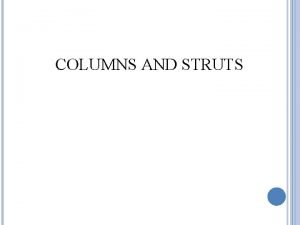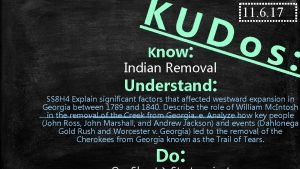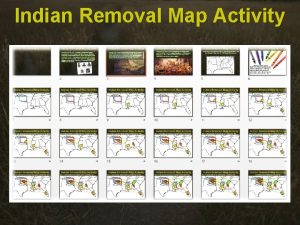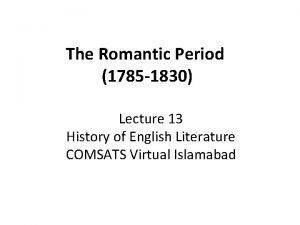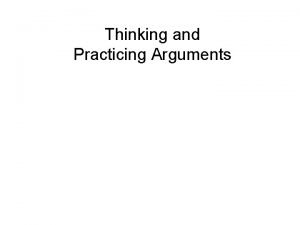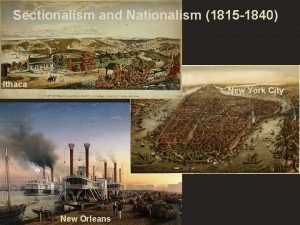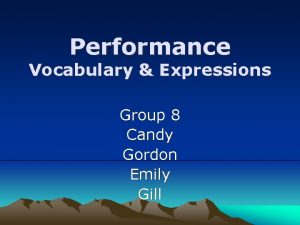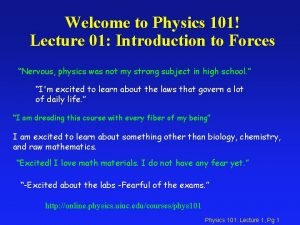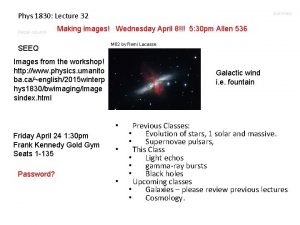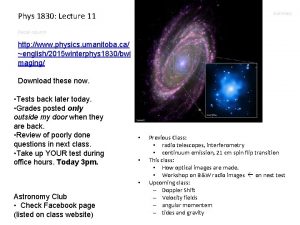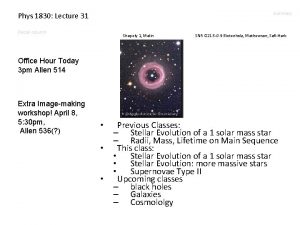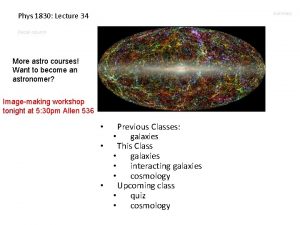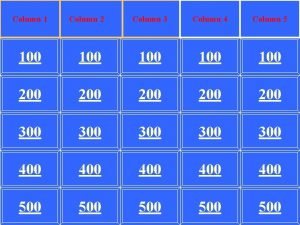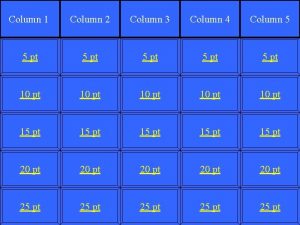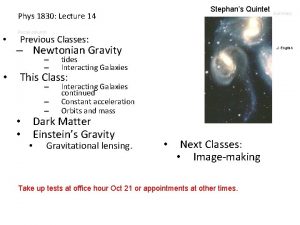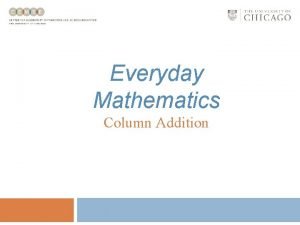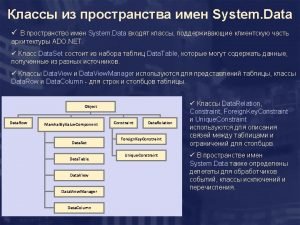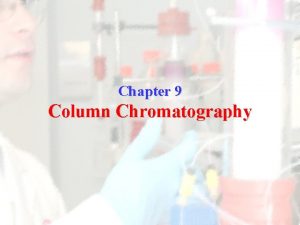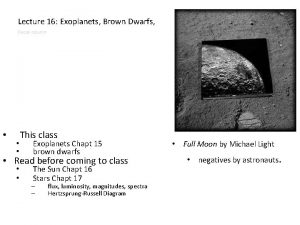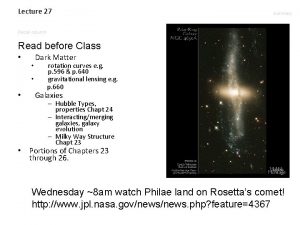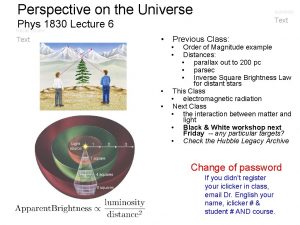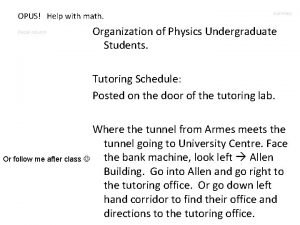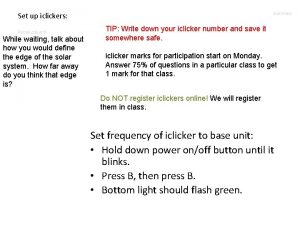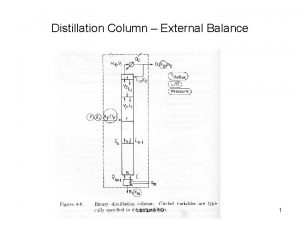Phys 1830 Lecture 12 summary Recall column The





























- Slides: 29

Phys 1830: Lecture 12 summary Recall column The Vela Cloud J. English Imaging workshop probably Friday Feb 13 th or Monday Feb 23 rd. • Coming up: GRAVITY • Previous Classes: Radio Images – Radio Telescopes – Radio Continuum emission – The radio emission line from HI (21 cm Spin Flip Transition) – Workshop on image-making This Class • Doppler Shift – Velocity Fields – Motion • • Angular Momentum Newton’s Laws

Test Recall column summary • The test was a) very easy b) easy c) just right d) hard e) very hard Average: 65% Take up test with me during office hour next week. Make other appointments. Keep tests about 2 weeks.

Best Answered Question – 100% of you got this right Recall column summary 11. The power of some well produced outreach images is their ability to intrigue the public sufficiently that people will turn to magazines, the internet, etc. to find out more information about the objects and phenomena in the images. a) True. b) False.

Question 4 summary Recall column 4. Fourth Image: Which statement is false about this image: a) The region is of the W 4 “chimney”. b) This image shows spectral line emission data. c) This image is made from radio continuum emission data. d) This image uses data acquired with a Canadian radio telescope.

summary • All parts of a statement need to be true for the answer to be correct. Recall column

23. You are designing a space-based telescope to observe newly formed hot stars. You wish to study Recall column the wavelength regimes with the most amount of energy emanating from the star. Therefore you would make sure the telescope system could detect emission in which of the following wavelength regimes? a) Any one wavelength regime would be appropriate for this study. b) Microwave and infrared. c) Infrared and gamma-ray. d) Radio and X-ray. e) Optical and ultraviolet. summary

Blackbody Radiation Curves for Different Temperatures Recall column summary Text 20, 000° K 10, 000° K Intensity 5000° K 2000° K 1000° K 500° K X-Ray Ultraviolet Visible Infrared Microwave Radio Wavelength (nm) Hot Star 30, 000 1000 Å Ultraviolet

23. You are designing a space-based telescope to observe newly formed hot stars. You wish to study Recall column the wavelength regimes with the most amount of energy emanating from the star. Therefore you would make sure the telescope system could detect emission in which of the following wavelength regimes? a) Any one wavelength regime would be appropriate for this study. b) Microwave and infrared. c) Infrared and gamma-ray. d) Radio and X-ray. e) Optical and ultraviolet. summary

Interferometry --- How do radio telescopes work? summary Recall column Discuss with neighbours: • Do radiio telescopes send out signals? • If they did, how long would the signal from your telescope take to go to a distant galaxy (Mpc away) and come back? • Would you be around to see the return signal? • Distance between antennas and the signal received are mathematically translated into position on sky and brightness. • The larger the distance between antennas the higher the resolution.

summary Recall column 30. Radio telescopes are used to send radar signals to astronomical objects such as nebulae and galaxies. The signals bounce back and are received at multiple antennas. The multiple antennas form an array used to synthesize a mirror over time. a) True. b) False.

Atmospheric Transmission summary Recall column N , O 2 2 H O, CO 2 2 ionized gases

summary Recall column 31. The two ranges of electromagnetic radiation for which Earth’s atmosphere is reasonably transparent are a) UV and radio waves. b) visible and far infrared radiation. c) X rays and visible radiation. d) visible and radio radiation.

summary Recall column • Take up rest of test in my office. • Please come on Monday 3 pm. Knock on my door even if someone is in there. • Try for other appointments next week.

Image-making Recall column summary

Examples of noise in the optical: Recall column 1) where the detector doesn’t acquire data. In GIMP one can select a rectangular region and then “bucket fill” that region with a neighbouring background colour. summary

Examples of noise in radio images: Recall column 2) Due to using individual antennas. 3) Emission not associated with target. Mitigate using careful stretching. summary

Examples of noise in radio images: Recall column 4) Artifacts due to using array of antennas and the brightness of nontarget objects. Very tricky to remove. If not done well “noise”. summary

21 cm Radio CONTINUUM – want to keep fog? It is data, not noise. Dominion Radio Recall column Astrophysical Observatory’s Snythesis Telescope The fog-like emission is synchroton emission. What does this tell you about the Milky Way’s environment? summary

60 micron – Far Infrared Emission (IRAS satellite) Recall column “rabbit ears” Black body emisson by dust. summary

Constructing Colour Images: The W 4 Chimney Region in the Milky Way summary Recall column How do we measure velocity? What is blueshift? • Radio Continuum data is coloured to distinguish thermal plasma and synchrotron emission. • HI radio data is coloured to show the motion in the gas. Blue is assigned to blueshifted gas rotation of the Milky Way.

Radio telescopes: Interferometry Recall column summary HI Photons from radio continuum or the 21 cm spin-flip transition. • Distance between antennas and the signal received are mathematically translated into position on sky and brightness. • The larger the distance between antennas the higher the resolution.

Doppler Shift summary Recall column • Emission or Absorption • 21 cm line • Emission lines are very useful for determining the motion of objects. To determine this we use the change in wavelength caused by the Doppler effect.

Doppler Shift: Recall column summary The tutorial showed that 1) Motion of the celestial object towards the viewer caused blueshifting of the lines. 2) Motion of the celestial object away from the viewer caused redshifting of the lines. 3) Motion of the celestial object perpendicular to the viewer did NOT cause shifting of the lines. Only the component of motion along the line of sight is measured. 4) the spectral lines shift but not the continuum emission.

Radio Arrays can generate spectral line cubes. summary Recall column Velocity field of NGC 3556 using HI 21 cm emission. Show kvis 3 D cube. • The 21 cm line is particularly useful since radio arrays make images per channel. • Professional astronomy tools like the Karma suite help astronomers interpret these 3 D cubes.

Doppler Shift summary Recall column • For measuring Doppler Shift use: – the absorption lines in stars. – the emission lines in gas.

Next Class Material Recall column summary

Example of another velocity field: The Vela Cloud summary Recall column • The galaxies rotation can be seen on right. • Note that the cloud doesn’t have any distinct flows.

Constructing Colour Images: The W 4 Chimney Region in the Milky Way summary Recall column • Radio Continuum data is coloured to distinguish thermal plasma and synchrotron emission. • HI radio data is coloured to show the motion in the gas. Blue is assigned to blueshifted gas rotation of the Milky Way.

Another example of velocity field: English & Taylorsummary Recall column • H I gas in our Milky Way which could effect our understanding of the Cosmic Microwave Background Radiation by absorbing microwaves. • The animation shows that this gas doesn’t have signatures of flow or rotation. Its motion is turbulent.
 Physics 241 purdue
Physics 241 purdue Completion of the accounting cycle
Completion of the accounting cycle Gianttoby
Gianttoby Ipcc ar5
Ipcc ar5 Recall column
Recall column Slenderness ratio of column
Slenderness ratio of column 01:640:244 lecture notes - lecture 15: plat, idah, farad
01:640:244 lecture notes - lecture 15: plat, idah, farad Liberty leading the people, 1830
Liberty leading the people, 1830 Ensayos constitucionales de chile entre 1823 y 1830
Ensayos constitucionales de chile entre 1823 y 1830 Map of us in 1830
Map of us in 1830 Two complaints of tejanos in 1830.
Two complaints of tejanos in 1830. Indian removal act
Indian removal act Indian territory map 1830
Indian territory map 1830 Map of america 1830
Map of america 1830 Congressional act of 1830
Congressional act of 1830 Liberty leading the people, 1830
Liberty leading the people, 1830 Constitucion de ecuador 1830
Constitucion de ecuador 1830 Romantic period timeline
Romantic period timeline 1830-1886
1830-1886 I moti del 1830
I moti del 1830 Where did revolution spread in 1830
Where did revolution spread in 1830 þq
þq I moti del 1830-31
I moti del 1830-31 Liberty leading the people 1830
Liberty leading the people 1830 Indian removal act of 1830
Indian removal act of 1830 Candy crush 1830
Candy crush 1830 Indian removal act of 1830
Indian removal act of 1830 Språkdebatten 1830
Språkdebatten 1830 Phys 102 uiuc
Phys 102 uiuc Phys 101 uiuc
Phys 101 uiuc


